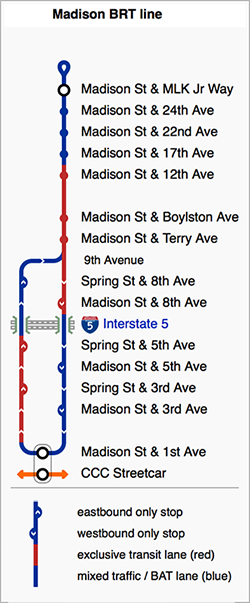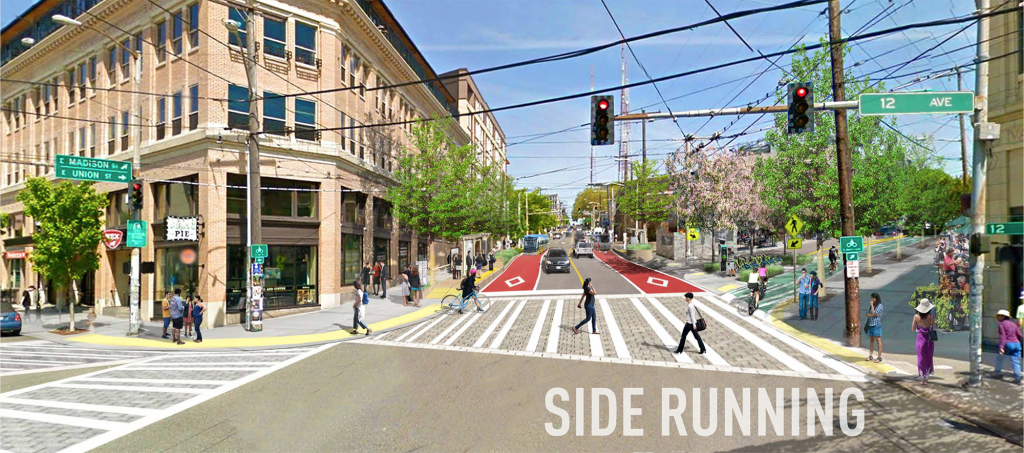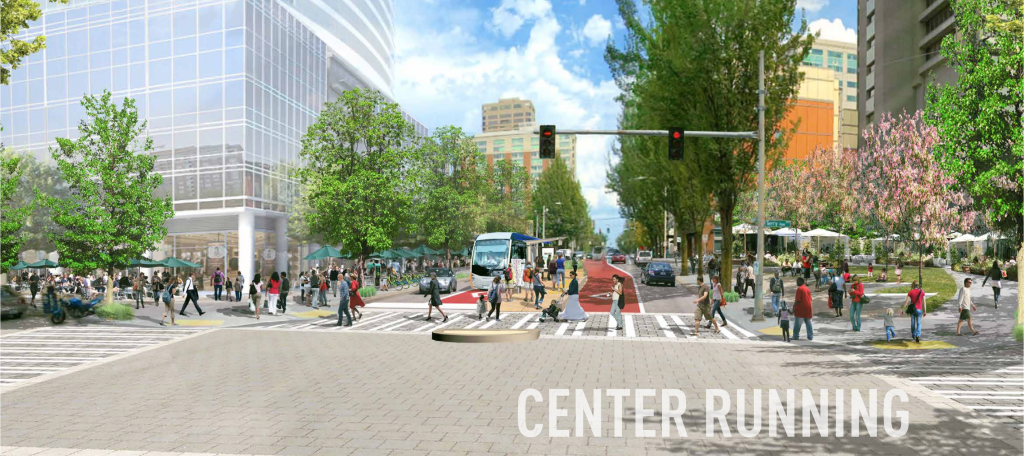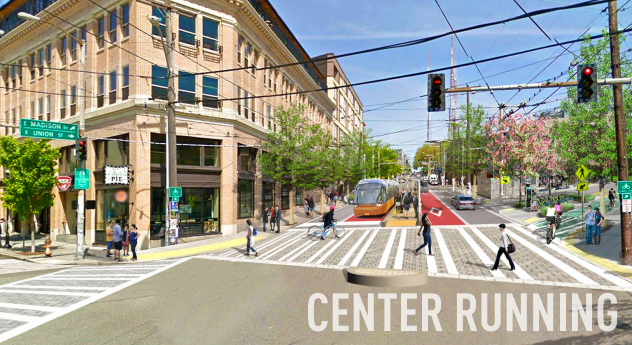
The Seattle Department of Transportation (SDOT) will be hosting an open house tonight to present the Preferred Design Concept for the Madison BRT line. The corridor extends from the Downtown Seattle waterfront all the way east to MLK Jr. Way in Madison Valley. Identified in the 2012 Seattle Transit Master Plan (TMP) as a critical High Capacity Transit (HCT) corridor, the Madison BRT project will bring fast, reliable, efficient bus service to one of the most congested corridors in Seattle. The Madison BRT line is one of the projects partially funded through the recently approved Move Seattle ballot initiative.
Effectively replacing King County Metro’s route 12 bus, the Madison BRT line will run from a shared BRT/Center City Connector Streetcar stop on First Avenue between Madison St and Spring St, eastbound on Spring St until 9th Ave, before continuing east on Madison St, all the way to Martin Luther King Jr Way.
The line uses a mix of transit-exclusive lanes in Downtown and on First Hill through 14th Ave, and will operate in mixed traffic east of 17th Ave.
There has been a lot of concern as of late on whether this project is suffering from BRT Creep — where the unique aspects of a true BRT line are eroded and degraded to the point where the line becomes no better than a normal bus line.
Currently, the line will feature an exclusive bus lane eastbound on Spring St to help bypass Interstate 5-bound traffic as part of SDOT’s plan to improve reliability of King County Metro route 2. On First Hill, the line will utilize center-running transit-exclusive lanes with center island platforms — because as a neighborhood, this is what we fought for. This is the only segment that currently will physically resemble “true BRT.”
East of First Hill, the center-running transit lanes first move to the curb lanes near 15th Ave and then will operate in mixed traffic from 17th Ave to Martin Luther King Jr Way.
The justification for degrading the line from “true BRT” to running in mixed traffic is simply that the long-term development plans for the Madison St corridor east of 13th Ave are relatively scant — and that vehicular traffic on this stretch of Madison St does not warrant the use of exclusive transit lanes. I have no doubts that this data is correct and SDOT has spent the past year studying the corridor.

Conversely, there is justification for the full-buildout of BRT on First Hill. The neighborhood is already one of the city’s densest high-rise residential and employment centers in Seattle — home to three of the city’s major hospitals. Furthermore, First Hill is expecting at least 5,000 new dwelling units to be built along the Madison BRT corridor in the next decade.

The issue that needs to be discussed at this point is not whether the eastern portion of the route will be BRT — it will offer the same station amenities, off-board payment requirement, real-time displays, and more as the rest of the route — but whether or not the investment should be made to keep the line running in the center of the roadway all the way from First Hill to the terminus at Martin Luther King Jr Way.
Regardless of one’s opinion on this matter, I believe that it is important that SDOT and the City hear that we want more than “just adequate” transit, in this corridor and others. Implemented correctly, this line will improve transit mobility in the corridor for decades to come, and more importantly, this line will help set the precedent for how future HCT bus lines in the city are planned and constructed.

The Five Essential Characteristics of “True BRT”
For a bus line to be considered “true BRT” it must follow these five essential characteristics1:
- Busway alignment — Defines where a busway’s dedicated lane is located on the road (e.g. center aligned, exclusive road, or along one side of the street). The busway is best located where conflicts with other traffic can be minimized. In most cases, the central verge (or median strip) of a roadway encounters fewer conflicts with turning vehicles than those closer to the curb.
- Dedicated right-of-way — An exclusive right-of-way is vital to ensuring that buses can move quickly and unimpeded by congestion. Enforcement of the dedicated lane can be handled in different ways, such as delineators, bollards, or colorized pavement.
- Off-board fare collection — Collecting fares before boarding, either through a “barrier controlled” or “proof-of-payment” method, is one of the most important factors in reducing station dwell time and therefore total travel time, thus improving the customer experience.
- Intersection treatments — There are several ways to increase bus speeds at intersections, all of which are aimed at increasing the green signal time for the bus lane. Forbidding turns across the bus lane and minimizing the number of traffic-signal phases where possible are the most important. Traffic-signal priority when activated by an approaching BRT vehicle is useful in lower-frequency corridors.
- Platform-level boarding — Having the bus-station platform level with the bus floor is one of the most important ways of reducing boarding and alighting times per passenger. The reduction or elimination of the vehicle-to-platform gap is also key to customer safety and comfort. A range of measures can be used to achieve platform gaps of less than 5 cm (2.0 in), including guided busways at stations, alignment markers, Kassel curbs, and boarding bridges.
Tonight’s (November 16) open house will be held at the Seattle Public Library (Main Branch) in Downtown from 5pm to 7pm. You’ll find the open house on Level 4 in Room 1.
If you are unable to attend this open house, SDOT would still love to hear your comments. Comments may be made online via email by contacting madisonbrt@seattle.gov.
Footnotes
- Institute for Transportation and Development Policy: BRT Basics
Gordon Werner
Gordon is a native New Yorker who wisely chose to leave the Northeast in the early 1990s. A past resident of Belltown, and Queen Anne, he currently calls First Hill home. He is a board member of the First Hill Improvement Association (FHIA) as well as the FHIA Transportation Committee Chair and is constantly looking for ways to improve transportation up the hill.

